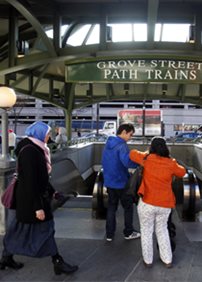Plan 2050: Transportation. People. Opportunity.




This page provides access to Plan 2050: Transportation. People. Opportunity. which was approved by the NJTPA Board of Trustees on September 13, 2021. Also approved on that date were the Transportation Improvement Program (TIP), and Air Quality Conformity Determination. The documents were the subject of a 30-day public comment period (beginning on July 6, 2021 and concluding August 4, 2021) as required by federal law.
Among the priorities of Plan 2050:
- Safety - Reducing crashes and ensuring the safety of all travelers must continue to be a primary focus across all policies, programs and investment.
- Accessibility - The region’s planning must continue to shift its focus away from moving vehicles to one of accessibility – that is, using a variety of modes to give people convenient and affordable access to jobs, education and other opportunities.
- Equity - The transportation system must more fully address the needs of low-income and minority communities, which have been traditionally underserved.
- Roads & Bridges - Fix it first is the priority to reduce the backlog of needed road and bridge improvements and upgrade facilities while also preparing infrastructure for climate change impacts.
- Transit - Improving transit is a key to solving some of the most difficult challenges but increased funding and more stable funding mechanisms are needed. The Hudson River tunnel project and the larger Gateway project are NJTPA’s top transit investment priorities.
- Active Transportation - Improve connectivity between neighborhoods and key destinations, especially in places with schools, high transit use and lower incomes.
- Climate Change – Support climate change policies and initiatives of the State of New Jersey – captured in the NJDEP’s October 2020 Global Warming Response Act 80x50 Report
- Transportation Technologies – Support transportation technology applications and guide the region in their use.
- Freight –Address existing freight infrastructure needs and prepare for growth in overall freight volume by 2050 as well as the challenges of e-commerce.
- Environment – A separate Environment chapter, highlights the importance of efforts in the areas of air quality, climate change and environmental mitigation.
- Financial Element – The plan offers a fiscally constrained financial plan based on realistic projects along with scenarios addressing more limited or additional funding.
Documents for Download:
Executive Summary — Text approved by the Board, Sept. 13, 2021.
Borrador del Plan de Transporte a Largo Plazo Resumen Ejecutivo — Plan 2050 Executive Summary in Spanish.
Full Document - Plan 2050 — Text approved by the Board, Sept. 13, 2021.
Summary of Public Comments — Summarizes comments received and provides NJTPA's responses.
Full Text of Comments — Full text of written comments submitted during the public comment period.
APPENDIX A: Background Papers
APPENDIX B: System Performance
APPENDIX C: Regional Capital Investment Strategy
APPENDIX D: Public Outreach
APPENDIX E: Demographic Forecasts
APPENDIX F: Congestion Management Process
APPENDIX G: Transportation Demand Management Plan
APPENDIX H: Air Quality Conformity Determination
APPENDIX I: Local Concept Development
APPENDIX J: Administrative Modifications to Plan 2050
Current Transportation Improvement Program (Adopted September 12, 2023)
FY 2022-2025 Transportation Improvement Program
Borrador del Programa de Mejora del Transporte Resumen (TIP Summary in Spanish)
Addendum
State Transportation Improvement Program